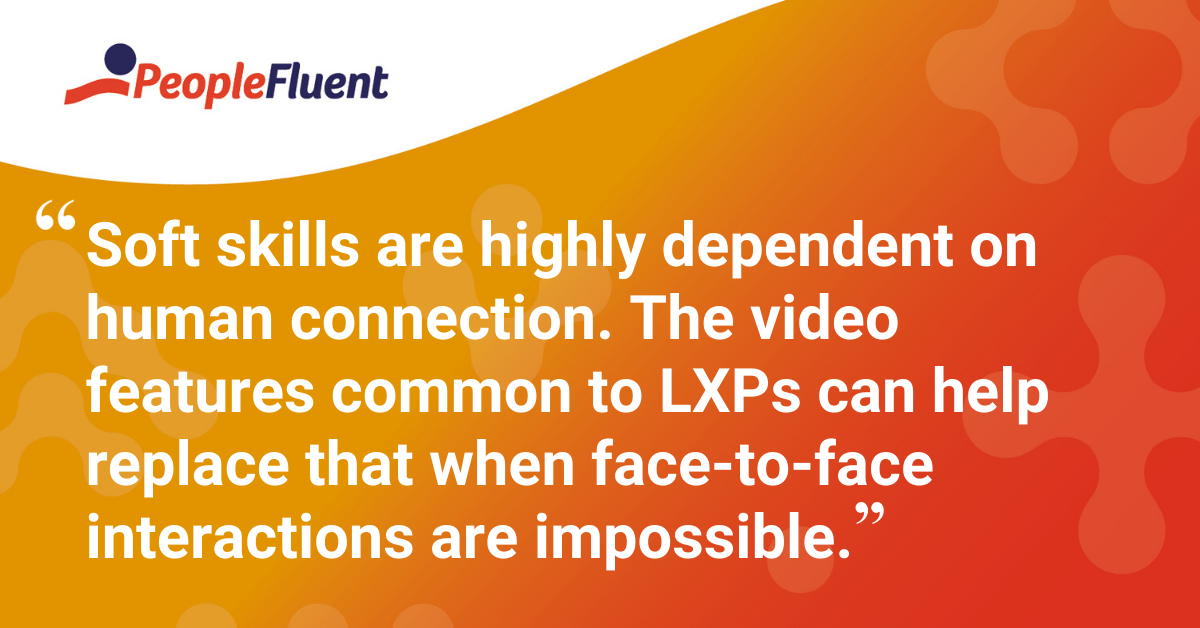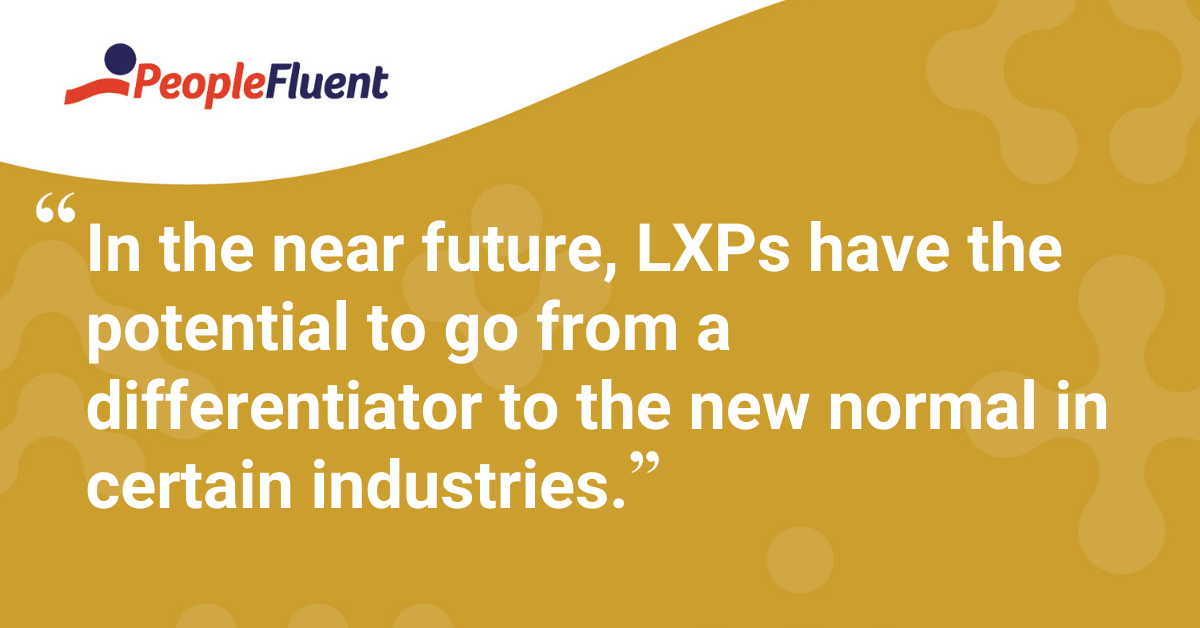Published: Feb 13, 2020Time to read: 6mins Category: Learning
How Learning Experience Platforms Support 6 of 2020’s Top Learning Trends
'Investment in Learning Experience Platforms’ has been featured in a major list of 2020’s top learning trends. In this article, we examine how LXPs actually provide solutions to many other trends in learning.
No matter the industry, the early months of the year see no shortage of outlets attempting to predict the year’s top trends. One set of eLearning predictions that caught our eye this year was Trends 2020: The Broadening Role of L&D, published in Training Industry Magazine.
This isn’t just because “High Capital Investment in Learning Experience Platforms” is named as a trend (one we’re rather biased towards seeing happen, for obvious reasons). Looking over the remaining trends, we were struck by how the LXP has a role to play in helping L&D rise to each challenge.
LXPs Can Support Soft Skills Training
The job market is set to change dramatically. Automation and artificial intelligence have the potential to transform the jobs they don’t replace. However, machines aren’t going to outperform humans for most soft skills—like creativity, agile thinking, communication, and collaboration—any time soon.
These kinds of skills are only going to become more important, and they require a different training approach. Training Industry points out that soft skills cannot be taught in a “one and done” fashion. Instead, they should be taught through multiple training experiences over an extended period of time. Learners need a chance to learn, practice and refine their approach.
LXPs deserve a place as one of the ‘multiple training experiences’ available to soft skills learners. Soft skills are highly dependent on human connection, and the video features common to LXPs can help replace that connection when face-to-face interactions are impossible. Furthermore, users could upload and ask for feedback on soft-skill performance via these platforms.

LXPs Can Help Us Adapt Training for the Gig Economy
The ‘gig’ economy is set to keep expanding, and 40% of companies expect increases to the number of gig workers they use. This presents a challenge to L&D departments who are typically set up to cater almost exclusively to long-term employees. It’s unusual for gig, freelance, and temporary workers to be enrolled in most company systems—including traditional learning portals.
LXPs can be set up to exist outside of the onboarding and enrollment systems. Gig workers are also not necessarily obliged to work through learning content, or they may not have time to review such material in a way that makes sense within their contract. Any platform that makes relevant learning information quick to consume and easy to find is more likely to engage them.
LXPs are already being used as a solution to serve content to these types of workers. An Instilled customer with a large indirect workforce notes that they are “highly attuned to discovering and consuming content online across a range of device types” and that an LXP “allows us not just to offer our content to this audience, but to present it in a way that reflects their positive personal experiences online.”
LXPs as a Familiar Environment for Customer Education
It’s rare to see successful technology thriving without some form of self-service help function. It’s also becoming increasingly common for tools, products, and services more generally to offer short videos or articles that answer frequently asked questions. Such tools emphasize intuitive user experiences. This is typically a marketing-led effort, but it’s easy to see how L&D could have valuable things to add to such ‘customer education’ experiences.
L&D’s tools could also have a role to play. ‘Short videos and articles’ and ‘intuitive user experiences’ are familiar elements of LXP usage and design. Many LXPs on the market are in part modeled after the presentation, UX and user journeys in popular websites (for instance, YouTube). It makes sense that consumers could benefit from LXP-enabled presentation of learning. In fact, Instilled is being used to deliver the ‘Gomo Academy’, a series of how-to materials for users of sister-company Gomo Learning’s authoring tool.
Related reading: ‘The Netflix of Learning’: An Appealing But Flawed Analogy for the LXP

Consolidated Data With Consolidated Learning in An LXP
Organizations are fueled by a huge amount of data. Meaningfully consolidating this data is a significant challenge. Training Industry suggests that companies investing in employee data literacy are pulling ahead across revenue growth, profitability and employee satisfaction. Nonetheless, L&D tends to lag behind in this area.
How can the LXP help out here? Firstly, from an organizational point of view, LXPs can create a single point of access for content distributed on disparate systems. This would bring together information for how these pieces of content are being used into a single place, where it would be highly portable for the purpose of analysis.
Secondly, the platform would also be a great place to stage data-skills training for L&D professionals. Training could range from full recorded seminars about different data approaches, to short off-screen demonstrations of how to use software to process data. The wide-range and high specificity of data-skills knowledge is well suited to being tagged and filtered for easy searching.
The LXP Expectation in Learning Culture
Organizations need to provide positive experiences across all aspects of employee experience in order to attract and retain workers. A strong learning culture is part of this equation, with employees expecting training and employers benefiting from increased employee potential.
LXPs are currently a key differentiator, and often indicate a more innovative and less rigid approach to learning. Employees with access to an LXP feel like they are trusted by the organization to self-direct and contribute to learning culture. In the near future, LXPs have the potential to go from a differentiator to the new normal in certain industries. Organizations without an LXP as part of their learning ecosystem may find that they become less desirable to potential employees as a result.

Conclusion: Increased Investment in LXPs
LXPs are themselves a trend. Training Industry’s article notes “an influx of capital investments and consolidation in learning experience platforms” in 2019. In turn, the motivations for using an LXP that they identify—content aggregation and supporting their employees at the time of need—are fueled by many of the trends mentioned above.
While the LXP certainly isn’t the only solution to the challenges that the decade ahead will bring, they are without a doubt a useful and versatile tool to have around.
A version of this post originally appeared on the Instilled blog.
Discover How Learning Builds Skills and Ensures Compliance
Design, deploy, track, analyze, and report on enterprise learning and compliance programs. PeopleFluent helps you execute your programs seamlessly, so employees upgrade their skills and you get results.